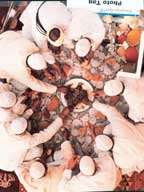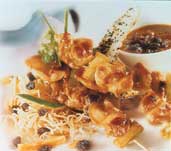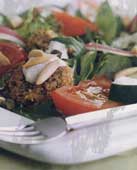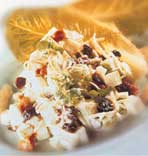
They call Mesopotamia, the fertile triangle of the Tigris and Euphrates Rivers, the birthplace of civilization. Agriculture was born here 12,000 years ago, and, since that nativity, food and drink have never seemed far from anyone's mind. Man first cultivated wheat here, and figs, dates, pomegranates, barley, and nuts were not far behind. Even our English word “gourmet,” meaning lover of fine food, derives from the Farsi word for stew: Ghormeh.
Geography accounts for much of the region's fascination with food. The Mid-East has been a crossroads, the cultural as well as geographical midpoint of the Euro-Asian-African world, and thus a hub of cookbook exchange. As travelers and merchants met here, they exchanged the foods and ingredients of their homelands and returned home with newly acquired culinary concepts. Early traders dealt in citrus, rice and spices. The Persians, who occupied the land of modern day Iran, laid the foundation for Mid-East cuisine when they incorporated rice, poultry and fruits into their diets. Tribal wars brought the portable foods of Arab warriors—figs, dates and nuts—to conquered lands. Mix in spices from India and beyond, pastries from the Turks, okra from Africa, and various contributions from Slavs, Mongols, and Moors and you begin to see the melting pot nature of the cuisine of the Middle East.
Religion, too, has channeled Middle East Eating habits. Both Jewish and Islamic dietary laws forbid pork consumption. Lamb is the primary red meat.

The Middle East Meal Table
Middle Eastern courtesy demands that a guest bring a healthy appetite to the dinner table. And for good reason! Variety rules in the Mid-East where appetizers, known as mezze, give the dinner table a wide mix of flavors and food forms. Restaurants in the region may serve 50 or more mezzes and advertise their numbers to lure customers. Popular mezzes familiar to Westerners include hummus (also spelled hoummous and homos); dolmas, stuffed grape leaves; the eggplant dip baba ganoush (ghannuj, ghanouj); and phyllo pastries.Chickpeas are staples of the diet, appearing not only in hummus, but in deep-fried balls called falafel, which are served as entrees. Breads rarely are excluded from a meal. Hence, the important social and religious concept of “breaking bread.” Varieties of leavened and flat breads are abundant. Shish kebab, skewers of grilled lamb or chicken coupled with chunk tomatoes and other vegetables, is a favored entrée, as are lamb stews.
Rice is frequently mixed with lamb, chicken and vegetables, fruits, and nuts. Cous cous, which has made a strong entry into the American diet over the last decade, is a common pasta form.

A Blend of Fine Cuisines
The borders of the Middle East are less a matter of geography than foods. Common threads link the cuisines of the area, but national and regional cuisines do stand distinct. In the heart of the Middle East are Saudi Arabia, Israel, Jordan, Iraq and other nations of predominantly Arabic peoples. To the north and curling west are Lebanon, Turkey, Greece, and Crete; to the south, Egypt and Sudan.Lebanese cuisine is typical of the Mediterranean diet, employing heavy quantities of garlic and olive oil at almost every meal. The Lebanese are proud of their chickpea dishes, hummus and falafel. Raw, pickled and cooked vegetables are consumed in abundance. Lamb is the preferred red meat, but often takes a backseat to fresh fish, seafood, and poultry, along with fruits vegetables, breads, and other starch products. Many primary meal items are grilled or baked or sautéed in olive oil. Herbs and spices play to the natural flavors of the fresh foods.
The Lebanese lay claim to contributing the cornerstones of Middle Eastern cuisine along with many of its most sophisticated dishes. Kibbeh is Lebanon's number one dish. It is an emulsified paste made of burgul wheat and lamb. The forms of kibbeh vary from raw (kibbeh nayee) to baked and fried. All are work-intensive dishes, requiring extensive pounding and kneading. Baked kibbeh is stuffed and layered. Fried kibbeh is stuffed and fried in olive oil. Both forms are commonly served with a yogurt sauce.
Bread seasoned with a thyme and sumac seasoning called zahtar is served at every meal, usually with olive oil, the effective substitute for butter or margarine. Israeli foods feature varieties of chicken-based products, including the famous chicken soups. Falafel, tahini, and salads of tomatoes and cucumbers, topped with a yogurt-like sauce, are typical of the cuisine.
The central religious holiday season of Passover brings with it a special menu. Religious law dictates the use of unleavened breads. Matzo, a flat cracker-like bread, becomes the dominant starch. “Chometz” foods, which are those that contain leavening or legumes, are not consumed during the eight-day period. Other Passover foods include beitzo, a hard-boiled egg; charozeth, a paste made of ground walnut, apples, and wine; and zeroah, a lamb shank or poultry neck.
Kosher products, which are primarily meat products killed, cleaned, handled and processed according to rigid standards, are popular with many non-Jewish American consumers concerned with food safety. What many Americans do not realize is that Islamic peoples conform to a similar code of food handling known as halal.
Like Lebanon and Israel, Egypt lays claim to marvelous falafel, chickpeas in meatball form. “Egypt produces a distinctive faul, a bean dish generally eaten in the morning,” notes Charles Stathacos, a marketing consultant to Mid-East processors including ALEB, an advisory organization for Egyptian food processors.
The fertile Nile delta provides a year-round growing season for vegetables, with winter green beans highlighting the production. A strong frozen vegetable industry has blossomed in Egypt, with IQF (individually quick frozen) technology on a significant upswing.
Both Egypt and Lebanon are major exporters of vegetables to Saudi Arabia, one of the largest Middle-Eastern markets. Key to food growth in the entire area is, of course, water. Egypt is extremely dry, hence the importance of the Nile to its food industry. Lebanon, on the other hand, has more diverse climate and features both rain-fed and irrigated lands for crops. The Bekaa Valley is its principal growing region.
Another Egyptian food is labne, a concentrated yogurt-like paste, which Stathacos calls “something between a yogurt and a cream cheese.” It is sold in refrigerated and shelf-stable jar forms.

Bringing the Middle East West
Many health-conscious Americans are pre-disposed to the Mediterranean diet, deemed exceedingly healthful with its emphasis on fish, grains, and vegetables, and its extensive use of heart-healthy olive oil in a wide array of cooked and freshly prepared items. The low rate of heart disease on the island of Crete often is offered as an example of one of the salubrious effects of the Mediterranean diet.Companies like the B. Manischewitz Company LLC (current parent RAB Holdings), Jersey City, N.J., have had a nearly captive market in some areas with their Jewish specialty products sold under the Manischewitz, Goodman's and Horowitz Marareten labels. Heading its product line-up are its “unleavened” grain products, the aforementioned matzo and tam tam flavored crackers. Matzo balls—dough balls of wheat flour—and Matzo ball soups, potato mixes and gefilte fish also fill the line. Other signature items include borscht, a beet-based beverage served hot or cold and often with sour cream.
Other major manufacturers and distributors of Israeli products include Aron Streit, Inc., New York, and Holon Middle Eastern Food, Brooklyn, N.Y., which markets the Osem, Orlando and Telma brands. Its lines include cous cous, falafel mix, tahina (a crushed sesame seed spread), jarred grape leaves, and pressed dates, date syrups and date spreads.
Greek cuisine also has a foothold in parts of the North American market, thanks largely to the multitude of Greek restaurateurs in cities like Chicago, Cincinnati, New York and other metropolitan areas. Like Lebanese, Greek cuisine has a “crossroads” quality, borrowing from both East and West. Seared gyros (pressed beef and lamb) on flat pita bread with cucumber sauce is a prized sandwich in many cities. But other dishes more typical of the Mediterranean eating style characterize the cuisine as well. Athenos, the U.S.-based marketer of eastern Mediterranean foods, has a nine-product hummus line that includes roasted garlic, scallion, cucumber dill, black olive and pesto varieties.
“Olive oil and feta cheese are blowing through the roof,” says Stathacos, referring to the ballooning popularity of Greek foods in the U.S. market. Most olive oil comes to the U.S. through Italian processors and distributors these days. But Stathacos expects processors from Lebanon, Egypt, and other Mid-East countries to promote their own olive oils in lucrative export markets in the years ahead. “Exporters see how much opportunity there is in the U.S., so they get very excited about the prospects,” he explains.
Stathacos thinks television will spread the culinary treasures of the Mid-East. On a recent excursion to the region, he saw Chef Ramzi, whom he calls “The Emeril of the Mid-East,” showing viewers how to use ingredients and assemble recipes from his cookbook on Lebanese foods. Ramzi may be the kind of emissary to spread Mid-East cuisines to the global village.
For information on ALEB, contact Charles Stathacos, 212-595-7122 or email stath@aol.com
Organic Hummus Tops List of Mediterranean Delights
“People are jumping on Mediterranean Cuisine,” says Nicole Day, savoring the double meaning of her statement. Not only are Americans embracing the healthful foods and food preparations of the Mediterranean diet these days, but they are purchasing the products of Mediterranean Cuisine, the company she co-owns with her mother, Joan Day.“We were raised with a love of healthful foods,” says the younger Day, a self-described vegan. They purchased the Mediterranean Cuisine lines of Israeli foods four years ago and have enjoyed 15- to 20-percent growth each year.
The company's most recent claim to fame is its Certified Organic Hummus line in five varieties: Original, Roasted Garlic, Tomato Basil, Lemon Pepper, and Spicy Peanut. At this writing, Mediterranean Cuisine is the only hummus processor to meet the recently released government standards for organic foods.
The Days' line includes 17 hummus varieties, three types of frummus (fruit hummus), falafel, tahini spread, falafel burgers (a Mid-East style veggie burger), a spinach and feta puffed pastry, whole grain salads, and baba ganouj. But Day has highest hopes for a nine-item line of vegan sandwich wraps featuring such varieties as Tubouleh and Hummus Wrap, Cous Cous Veggie Hummus Wrap, Mediterranean Falafel, and Garden Lentil and Hummus Wrap.
While Mediterranean Cuisine has experienced steady growth in the retail sector, foodservice sales have hit fast. “The biggest demand has come from the colleges and universities in the Northeast,” says Day. The institutions of Yale, Harvard, Boston College, the University of Massachusetts and the University of Vermont are among her customers. Conscious of the importance of healthful institutional feeding as well as the ethnic mix of their patients, hospitals also have taken interest in the line.
Website Resources
www.aleb.org— Agriculture-Led Export Businesses (ALEB) supporting Egyptian food processing companieswww.globalgourmet.com/destinations/— Links to descriptions of various countries' cuisines and historical background
www.middleeastuk.com/culture/cuisine/— Introduction to Middle East cooking and recipes
www.pbm.com/~lindahl/cariadoc/recipe_toc.html— Table of contents to Islamic recipes
www.ou.org/kosher/kosherqa/food.htm— Kosher laws
www.dscp.dla.mil/subs/rations/meals/halman.pdf— Halal industrial production standards
www.calraisins.org/Consumer/recipes.html— See Ethnic Foods under recipes
www.manischewitz.com— Manishewitz food company